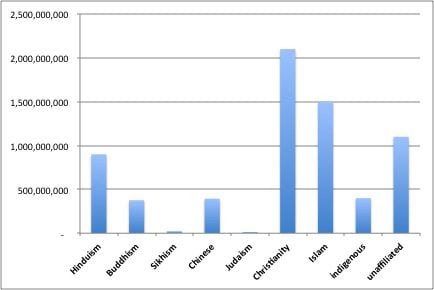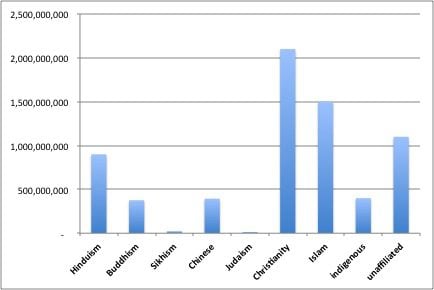The overarching purpose of this entire “Religion 101” blog of mine is primarily to introduce newcomers to the study of religion, as well as newbies just starting out on a personal spiritual search, to the wider world of global religion and spirituality. It’s also my own modest contribution to the wider “war on religious illiteracy.”
Many people embarking for the first time upon such religious studies or spiritual searches find themselves initially faced with sometimes some very unfamiliar terrain, and so through this blog I hope to help such people to find their initial bearings — to orient them to the broader religious and spiritual landscape that exists out there.
If I myself was utterly brand new to the study of religion — if I knew absolutely nothing, going in, regarding the bigger global picture of human religiosity and spirituality — then I know that I would probably need some sort of broad and general overall orientation to that bigger picture, before going on to explore the specific beliefs, practices, and fine points of each of the world’s religious traditions and spiritual pathways.
In other words, if I were from Mars, and knew nothing of Earth’s religions, then I’d probably want to start out by asking such broadly basic “overview” questions as:
How MANY religions are there?
How BIG are these religions?
How OLD are these religions?
(Then, once I had some grasp of the big picture, I would at least have some sense of the broader context within which all of these individual particular religions fit, as I then began to put each religion under my microscope — one by one — in order to examine the specific beliefs and practices of each of them.)
I recently concluded a five-part series which already asked the question, How many religions are there? So, I’d like to turn now to addressing the other two questions.
Actually, in other previous blog entries, I’ve also already touched upon the question, How big are the religions? In those previous posts, I presented both a global religious pie chart as well as a U.S. religious pie chart, which illustrated the population sizes of the various major religions relative to each other.
However, in those posts I merely ranked the religions by size, and presented only the percentage of the total human population — worldwide, or just that of the U.S. alone — that each religion represents or accounts for (e.g., Christianity represents 31% of the total world population, but 79% of the total U.S. population; Islam represents 22% of the global population, but less than 1% of the U.S. population; Judaism represents less than 1% of the world’s populace, and just under 2% of the U.S. populace; etc.).
However, I didn’t provide the actual specific population numbers (the total “head counts”) existing within each individual religion.
I also limited those pie charts to just the major religions alone, since so many other religions which might also have been included actually have populations of adherents that are so small that their respective individual slices of the total pie would have been too small even to register.
Now, I’d like to fill in those omissions. And instead of pie charts, I’ll do it with bar graphs.
Firstly, here is how just the major religions alone rank, in terms of their own population sizes (their individual total numbers of adherents, worldwide):
As you can see, Christianity is currently the world’s largest religion, with just over 2 billion followers worldwide. Islam takes second place, with about 1.5 billion adherents globally.
Hinduism comes in as the world’s third largest religion, with just under 1 billion followers. However, the third largest bar on the graph actually belongs to the religiously unaffiliated, who as a group currently number just over 1 billion non-adherents.
Buddhism pretty much ties with traditional Chinese religions (itself comprised of Confucianism, Taoism, and native Chinese folk religion), with each of these two subgroups comprising perhaps a little under half a billion followers each.
The diverse category of indigenous religions (Native American religions, traditional African religions, Australian aboriginal religion, etc.) is probably about on par with Buddhism or Chinese religion, with a collective total of perhaps nearly half a billion adherents worldwide.
Sikhism and Judaism, compared with all of these giants, scarcely even register on this scale, with perhaps 23 million Sikhs and only 14 million Jews in the world. (Note that we’re now talking in terms of millions, and not billions.)
(To be continued, and concluded, in Part Two.)


